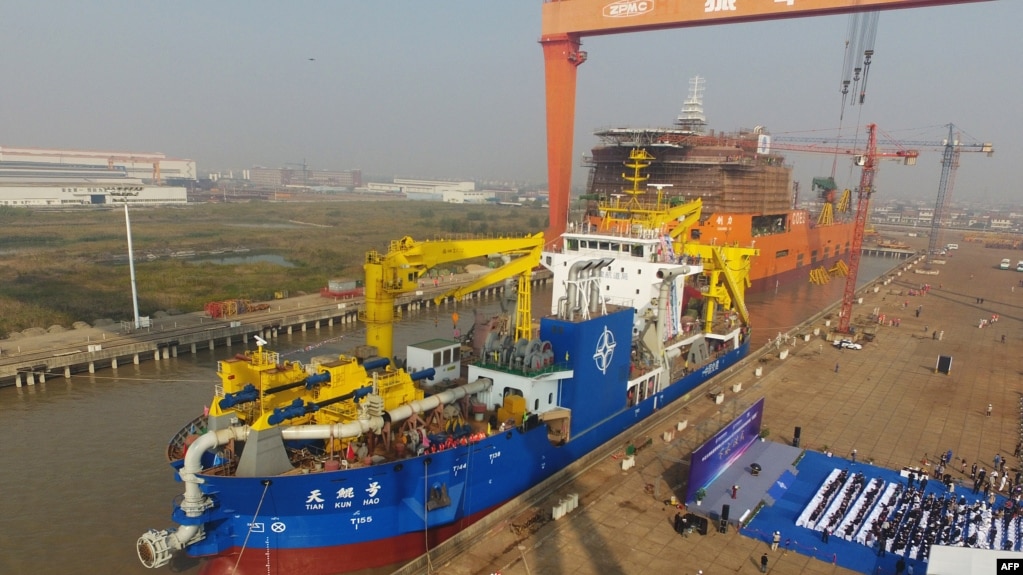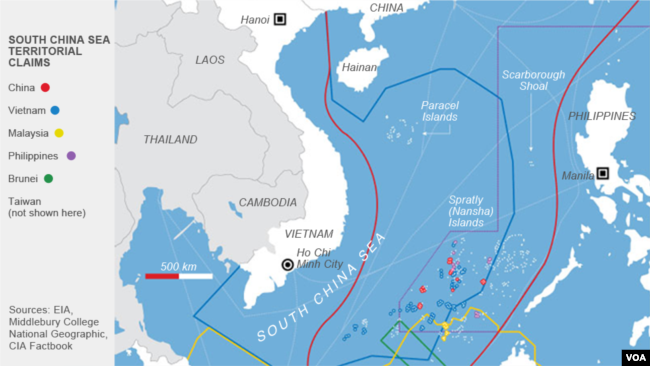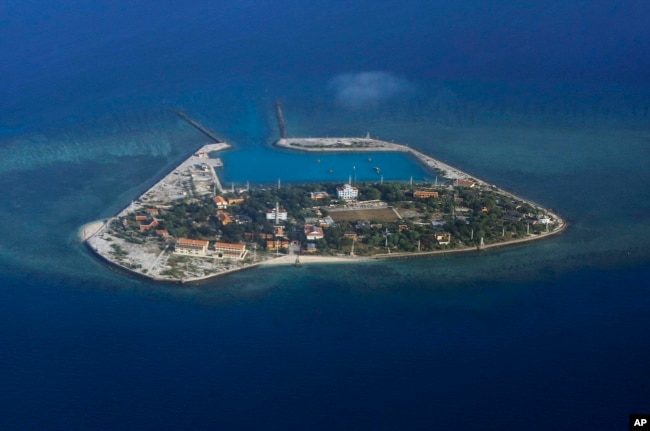Test of Chinese Vessel in Contested Sea Adds Speed Bump to Diplomacy
VOA NEWS
November 06, 2017 8:27 AM
TAIPEI, TAIWAN —
China’s announcement of a super-sized reclamation vessel for use in the disputed South China Sea stands to rile much of Asia as well as the U.S. government during a month of meetings among the region's top leaders.
Beijing has begun testing Asia’s largest deep-water dredging vessel, the Tian Kun Hao, according to the state-run China Daily’s website Sunday. The report said the140-meter-long vessel can dredge 6,000 cubic meters of land per hour up to 35 meters under the sea floor.
The vessel can accelerate the creation of artificial islands, a process that would let it expand control of the South China Sea where most natural features are too small for development.
“From a diplomatic angle, it does not transmit a positive message at this moment,” said Alexander Huang, strategic studies professor at Tamkang University in Taiwan.
“I don’t know why they are doing this, because based on the traditional Chinese strategic culture, it does not encourage showing strength during a period of uncertainty,” Huang said. “It might mean that China is much more confident than what they can do and they will be not be bothered by the views of the neighbors or parties concerned.”
Senior-level meetings ahead
China claims about 90 percent of the 3.5 million-square-kilometer body of water, overlapping the claims of Brunei, Malaysia, the Philippines and Vietnam.
Senior Chinese leaders are due to meet through mid-November with counterparts from as many as 10 Southeast Asian countries as well as U.S. President Donald Trump, who is making his first visit as president to Asia.
The South China Sea issue has become low-key over the past year as rival claimants talk with China about development aid and maritime cooperation, including a code of conduct aimed at preventing clashes at sea.
To smooth diplomacy, nations including China often shelve controversial actions until after high-level meetings. The U.S. government, for example, delayed approval of an $1.4 billion arms sale to Taiwan until three months after Trump had met Chinese President Xi Jinping in April. Xi would have been angered as China sees self-ruled Taiwan as part of its territory.
Avoid offending Manila
China will probably hold off dredging more of the Spratly Islands, which total about 100 tiny features to make up the most widely contested archipelago in the resource-rich sea, said Jay Batongbacal, director of the Institute for Maritime Affairs and Law of the Sea at the University of the Philippines.
That delay would protect a Sino-Philippine friendship that has formed over the past year, he said. Manila won a world court arbitration ruling in July 2016 over the extent of China’s maritime claims, capping off four years of hostilities. The Philippines controls nine Spratly islets.
Since October last year, the two countries have set aside the dispute as China prepares billions of U.S. dollars in aid and investment for the Philippines.
China has used an estimated 3,200 acres (1,294 hectares) of landfill to build artificial islets in the Paracel and Spratly chains, partly for military infrastructure. The Chinese military is stronger than the armed forces of other countries with maritime claims.
The dredging vessel can extract land from an area the size of a meter-deep soccer field within an hour, China Daily reports. The Southeast Asian maritime claimants lack China’s budget and level of expertise to develop their own deep-sea reclamation equipment, Batongbacal added.
Where the dredger might excavate first
China may use the dredging vessel first to landfill in the Paracel Islands, a chain of some 130 tiny features, he said.
“They’re already continuing with respect to the Paracels, so I think for the Spratlys, they’ll probably go back when in their view conditions security-wise will warrant it,” Batongbacal said.
Testing of the Chinese dredging vessel is most likely to irritate Vietnam because it also claims the Paracel chain but lacks effective control of it, said Le Hong Hiep, research fellow with ISEAS Yusof Ishak Institute in Singapore. Seven Chinese-held islands in the Spratly chain are built out, he said, making the Paracels a likely next target.
Sino-Vietnamese hostilities
Vietnam and China, which have faced territorial disputes for centuries, rammed each other’s boats in 2014 after a Chinese company placed an oil rig about 240 kilometers east of Vietnam. China forced Vietnam to cancel an undersea fuel explanation project in June this year, analysts believe.
More construction in the Paracels would erode Vietnam’s claim as well as international support for it, Le said.
“I think [the dredging vessel] is part of China’s plan to build artificial islands in the South China Sea and to consolidate its footholds in the region,” he said.
But China probably announced the vessel not to coincide with high-level meetings this month, rather as part of a longer “roadmap” for its maritime expansion, Le said.
In Vietnam this month, Xi is scheduled to meet the Vietnamese president, prime minister and ruling party head, its official Xinhua News Service said. Those meetings will tell whether the dredger’s release has impact, Le added.
U.S. Defense Secretary Jim Mattis might also get upset about the dredger, Huang said. Mattis in June said construction and militarization of artificial islands “undermine regional stability,” according to a Department of Defense transcript.





No comments:
Post a Comment